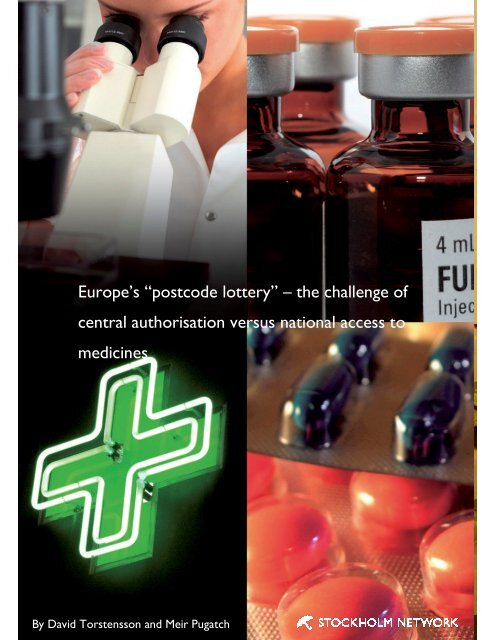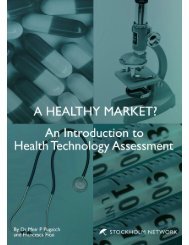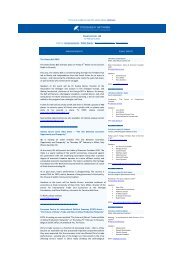Download this publication - The Stockholm Network
Download this publication - The Stockholm Network
Download this publication - The Stockholm Network
You also want an ePaper? Increase the reach of your titles
YUMPU automatically turns print PDFs into web optimized ePapers that Google loves.
Europe’s “postcode lottery” – the challenge of<br />
central authorisation versus national access to<br />
medicines<br />
By David Torstensson and Meir Pugatch<br />
1
Europe’s “postcode lottery” – the challenge<br />
of central authorisation versus national<br />
access to medicines<br />
By David Torstensson and Meir Pugatch<br />
© <strong>Stockholm</strong> <strong>Network</strong> 2009. <strong>The</strong> views expressed in <strong>this</strong> <strong>publication</strong> are those<br />
of the authors and do not necessarily represent the corporate view of the<br />
<strong>Stockholm</strong> <strong>Network</strong> or those of its member think tanks.<br />
2
Foreword<br />
<strong>The</strong> <strong>Stockholm</strong> <strong>Network</strong>’s health and welfare programme was set up to examine the issue of<br />
healthcare system reform from the point of view of consumers of healthcare. Our vision is of a<br />
sustainable, consumer-driven health system which pools risk, draws in investment and attracts<br />
sufficient funding from a variety of sources to make high quality treatment available to all.<br />
In <strong>this</strong> context, our overall research programme asks the following types of questions: Do European<br />
health systems work better or less well than in other countries? Would market-oriented policies lead<br />
to better outcomes than government-led ones and, if so, why? Do European policies encourage<br />
innovation and give patients access to the most cutting edge medicines and treatments?<br />
Turning to the last of these questions, <strong>this</strong> paper examines in detail the state of the European<br />
pharmaceutical market as a whole and asks what impact European regulatory structures are having on<br />
patients’ ability to access medicines promptly. Is there a gap between the theory and practice<br />
regarding when patients in different EU member states can get hold of the medicines they need and, if<br />
so, what can be done to speed up the process?<br />
This paper attempts to shed some light and provide some answers to these important questions<br />
about Europe’s current and future state of health.<br />
3
Executive Summary<br />
This paper looks at two important regulatory and budgetary aspects linked to the issue of access to<br />
medicines in Europe. <strong>The</strong> first aspect concerns the approval process of a new medicine or treatment<br />
– the difference between the time it takes to approve a medicine for use by the European Medicines<br />
Agency (EMEA) and the time when patients may be able to purchase <strong>this</strong> medicine in their respective<br />
countries. <strong>The</strong> second aspect deals with the time it takes national authorities to reach a decision<br />
about the reimbursement status of different medicines and treatments, once they have been<br />
authorised for market use.<br />
Accordingly, the paper focus on two empirical questions: Are there significant differences in the time<br />
it takes after a medicine is approved for market by the EMEA and the date when it actually becomes<br />
reimbursed and thus fully available to most Europeans? And what has been the effect of many EU<br />
countries’ policies relating to the cost of pharmaceuticals on the actual availability of medicines and<br />
treatments to patients?<br />
By looking at a sample of 40 medicines in two EU Member States, Denmark and Sweden, <strong>this</strong> paper<br />
has found that there exists a significant time delay between the approval of a medicine for market<br />
through the European Centralised Procedure of EMEA and the time when that medicine becomes<br />
available to many European patients through reimbursement. For Sweden and Denmark the results of<br />
<strong>this</strong> sample are not encouraging. <strong>The</strong> averages range from a high of 331.1 and 397.8 days respectively<br />
for each country to a low of 199 and 261. Even at the lowest range <strong>this</strong> is still a time lag of close to<br />
nine months for Denmark and over six months for Sweden.<br />
In addition, <strong>this</strong> paper has found that there are large variations between individual Member States<br />
regarding when a specific medicine or therapeutic class of medicines and treatments become<br />
reimbursable and thus accessible to the majority of patients. For instance, Swedes have to wait<br />
considerably less to receive reimbursement for Oncologics and Cancer-related treatments than their<br />
Danish counterparts. For the seven medicines sampled in <strong>this</strong> therapeutic class, Swedes had to wait an<br />
average of 159.6 days, whereas in Denmark a reimbursement decision took almost 200 days longer at<br />
348.3 days. <strong>The</strong> opposite can be said for Antipsychotics and Antidepressants. For these medicines the<br />
Danish approval process took on average 241.1 days, whereas in Sweden the process reached almost<br />
a full year at 337 days. <strong>The</strong>se discrepancies are so large that one can talk of a ‘postcode lottery’: a<br />
patient’s national address within the EU determines when they can access a particular medicine or<br />
treatment, rather than when it was first approved by EMEA.<br />
By comparing the date of EU-wide market approval of a medicine or treatment through the European<br />
Medicines Agency (EMEA) with the date on which the medicine is first reimbursed in an individual<br />
Member State <strong>this</strong> paper finds that that Europe still has a long way to go before having a "single<br />
pharmaceutical market".<br />
4
1. Introduction<br />
Much has been discussed in the academic literature with regard to different policies that aim to<br />
increase access to medicines in different countries. Yet (and as will be discussed later in <strong>this</strong> paper)<br />
such discussions tend to focus on different policies that both aim to reduce the price of a given<br />
medicine (so called cost containment) and to expedite the introduction of cheaper alternatives, most<br />
commonly via the introduction of generic medicines.<br />
<strong>The</strong> underlying rationale behind such policies is that by reducing the amount of spending on a given<br />
medicine (or medicines) it would be possible to use these savings to finance additional medicines and<br />
healthcare technologies in general.<br />
In national systems where the financing of medicines is based (in large or in part) on the public purse<br />
(i.e on national reimbursement mechanisms) it is certainly legitimate to consider and discuss the<br />
rationale, logic and purpose of such cost-containment models.<br />
However, <strong>this</strong> does not mean that other questions concerning access should be sidelined. In <strong>this</strong><br />
context, and not least in Europe, one may ask the following questions:<br />
Is the access to a given medicine affected by the actual availability of that medicine in a given<br />
country?<br />
Is the access to a given medicine affected by the decision about whether to reimburse <strong>this</strong><br />
medicine in that country?<br />
<strong>The</strong> answer to both of these questions is, of course, yes. However, these questions are not only<br />
theoretical. In fact, they are very real.<br />
Since its inception in the mid 1990s the European Medicines Agency (EMEA) and its precursor have<br />
increased the efficiency and speed at which medicines and pharmaceutical treatments are brought to<br />
market. Most patients, policymakers, and other stakeholders would agree that EMEA’s Centralised<br />
Procedure of medicine authorisation has proven to be a success.<br />
But in Western Europe, where so much of healthcare is either publicly funded or provided, obtaining<br />
regulatory approval for bringing a new medicine to market is only the first stage in bringing that<br />
medicine to the patient. For patients to gain actual, practical access to a newly EMEA-approved<br />
medicine or treatment, in most EU Member States that medicine must also be approved for<br />
reimbursement by a national medicines regulator.<br />
5
<strong>The</strong>refore, while the overall effect of EMEA has been to centralise and improve the market<br />
authorisation process, reimbursement decisions still vary across Europe from medicine to medicine<br />
and country to country. Consequently, while a medicine or treatment may have received market<br />
approval for EU Member States at the same time, individual reimbursement policies still determine<br />
when, and if, patients will be able to access new medicines and treatments.<br />
In <strong>this</strong> context <strong>this</strong> paper compares the date of approval of a pharmaceutical medicine by EMEA’s<br />
marketing authorisation authority with the date on which the same medicine is eligible for<br />
reimbursement.<br />
However, in order to obtain a better understanding of <strong>this</strong> comparison it is important to first outline<br />
(in brief) how European healthcare systems review and approve new medicines for market use, as<br />
well as how different countries determine the pricing and reimbursement of such medicines.<br />
This paper consists of two sections. Section 1, Pharmaceuticals and European Health Care Systems,<br />
outlines some facts about how Europe’s health care systems and pharmaceutical policy are organised<br />
both at a centralised EU level, and at the level of the individual Member State. It focuses on<br />
pharmaceutical policy and specifically on how medicines are approved for market, how they are<br />
priced, and how reimbursement levels are set. <strong>The</strong> aim of <strong>this</strong> section is not to detail all variations in<br />
policy and implementation of public health and medicines policy across all Member States, but to<br />
highlight some of the major important trends and policies of recent years. <strong>The</strong> purpose is to broadly<br />
describe how pharmaceutical policy works and how policymakers have attempted to grapple with the<br />
rise in health care spending by, amongst other things, limiting expenditure on pharmaceuticals.<br />
Section 2, Market Authorisation and Reimbursement, compares EMEA’s market authorisation date for<br />
a sample of 20 medicines versus the date of reimbursement in two sample EU countries: Sweden and<br />
Denmark. <strong>The</strong> purpose of <strong>this</strong> section is to provide some real data on the relationship between these<br />
two dates: Is there a significant time lag between when a medicine is approved for sale and use and<br />
when it is reimbursed? Are there variations in when a medicine can first become reimbursed between<br />
these two countries?<br />
Overall <strong>this</strong> paper asks two simple questions: Are there significant differences in time when a<br />
medicine is approved for market by EMEA and when it becomes reimbursed and thus fully available to<br />
most Europeans? And what has been the effect of reimbursement policies on the availability of<br />
medicines and pharmaceutical treatments to patients across Europe?<br />
2. Pharmaceuticals and European Health<br />
Care Systems<br />
6
Pharmaceutical medicines and treatments are a big part of European health care and medical<br />
treatment. In fact, Europeans are almost as keen in their use of pharmaceuticals as the biggest market<br />
in the world: North America. According to the latest estimates from the health consultancy IMS<br />
Health, the total unaudited and audited pharmaceutical market for Europe in 2008 was $247.5billion. 1<br />
(This is in comparison to the North American market which was valued at $311.8billion.) Since in<br />
many of Europe’s biggest health care markets governments are the main purchasers of care, much of<br />
<strong>this</strong> expenditure comes either directly or indirectly from the public purse. For example, the UK’s<br />
National Health Service (a publicly provided and funded health service) is one of the biggest<br />
purchasers of medicines in the world. This is an important point and helps to explain why many of the<br />
policies European countries have historically adopted to curb health care spending focus, among other<br />
things, on cutting medicine spending.<br />
<strong>The</strong>se policies are not, and have never been, uniform across the European continent. Instead, they<br />
vary from country to country and in their overall impact on each individual country’s health system’s<br />
standard of care. In Germany, for example, policymakers have historically maintained their<br />
commitment to cut the perceived rising costs of pharmaceutical medicines through reference pricing,<br />
price freezes, across the board reductions on non-referenced priced as well as referenced-priced<br />
medicines, and the imposition of rebates on manufacturers. 2 Many other countries have similar aims,<br />
but different policies. For example, both Ireland and Spain have systems of rebates whereby a portion<br />
of sales made by a manufacturer are returned to the institutional purchaser. 3 And, in the UK,<br />
medicine expenditure is contained through a system of profit control of branded pharmaceuticals. 4<br />
Before outlining in more detail what the most common policies are and how they have been<br />
implemented across the EU, it is worth describing some of the basic facts about how Europeans<br />
access their medicines.<br />
<strong>The</strong> regulation of the pharmaceutical medicines market: marketing authorisation and<br />
reimbursement<br />
For a pharmaceutical medicine or treatment to become available within the EU it must go through a<br />
process of market authorisation. This process is meant to test and ensure the safety of the treatment<br />
and is a prerequisite to the bringing to market of a new medicine. For EU Member States, EU<br />
legislation defines three main procedures for the marketing authorisation of medicines: the<br />
Centralised procedure, the Mutual Recognition and Decentralised procedures, and National<br />
procedures.<br />
1<br />
IMS, ‘Total Unaudited and Audited Global Pharmaceutical Market by Region’, IMS Health Market Prognosis, March 2009. See:<br />
http://www.imshealth.com/portal/site/imshealth/menuitem.a46c6d4df3db4b3d88f611019418c22a/?vgnextoid=cec0977ccedc0210<br />
VgnVCM100000ed152ca2RCRD&cpsextcurrchannel=1<br />
2<br />
‘Reference Pricing of Pharmaceuticals for Medicare: Evidence from Germany, <strong>The</strong> Netherlands and New Zealand’, Patricia M.<br />
Danzon and Jonathan D. Ketcham, National Bureau of Economic Research, Working Paper 10007, September 2003 and Valérie<br />
Paris and Elizabeth Docteur, Pharmaceutical Pricing and Reimbursement Policies in Germany, OECD, 2008:22<br />
3<br />
Jaime Espin and Joan Rovira, “Analysis of differences and commonalties in pricing and reimbursement systems in Europe”, A paper<br />
funded by DG Enterprise and Industry of the European Commission, p. 29.<br />
4<br />
Ibid. p. 30.<br />
7
<strong>The</strong> Centralised procedure for authorising biotechnology-derived and high-technology medicines is<br />
laid out in Regulation (EEC) No 726/2004. This procedure, which came into operation in 1995, allows<br />
applicants to obtain a marketing authorisation that is valid throughout the EU. It is compulsory for<br />
medicinal products manufactured using biotechnological processes, for orphan medicinal products<br />
and for human products containing a new active substance which was not authorised in the<br />
Community before 20 May 2004 (date of entry into force of Regulation (EC) No 726/2004) and which<br />
are intended for the treatment of AIDS, cancer, neurodegenerative disorder or diabetes. 5 <strong>The</strong><br />
Centralised procedure is optional for any other products containing new active substances not<br />
authorised in the Community before 20 May 2004 or for products which constitute a significant<br />
therapeutic, scientific or technical innovation or for which a Community authorisation is in the<br />
interests of patients’ health at the Community level. When a company wishes to place on the market<br />
a medicinal product that is eligible for the Centralised procedure, it sends an application directly to<br />
EMEA, to be assessed by the Committee for Medicinal Products for Human Use (CHMP). <strong>The</strong><br />
procedure results in a Commission decision, which is binding on all EU Member States, to authorise<br />
the product. Centrally-authorised products may be marketed in all Member States.<br />
For a medicinal product to be eligible for the Mutual Recognition procedure it already needs to have<br />
obtained a marketing authorisation in one Member State. <strong>The</strong> mutual recognition procedure is based<br />
on the principle of the mutual recognition by EU Member States of their respective national marketing<br />
authorisations. An application for mutual recognition may be addressed to one or more Member<br />
States. <strong>The</strong> applications submitted must be identical and all Member States must be notified of them.<br />
As soon as one Member State decides to evaluate the medicinal product (at which point it becomes<br />
the “Reference Member State”), it notifies <strong>this</strong> decision to other Member States (which then become<br />
the “Concerned Member States”), to whom applications have also been submitted. Concerned<br />
Member States will then suspend their own evaluations, and await the Reference Member State’s<br />
decision on the product. Should any Member State refuse to recognise the original national<br />
authorisation, on the grounds of potential serious risk to public health, the issue will be referred to<br />
the coordination group. Within a timeframe of 60 days, Member States shall, within the coordination<br />
group, make all efforts to reach a consensus. In case <strong>this</strong> fails, the procedure is submitted to the<br />
appropriate EMEA group for arbitration. <strong>The</strong> opinion of the EMEA Committee is then forwarded to<br />
the Commission. <strong>The</strong> Commission will then decide on granting or refusing a marketing authorisation<br />
valid in all member states.<br />
<strong>The</strong> Decentralised procedure applies for medicinal products which have not received a marketing<br />
authorisation in any EU Member State at the time of application and are not required to apply under<br />
the Centralised procedure. <strong>The</strong> Decentralised procedure is also based on recognition by national<br />
authorities of a first assessment performed by one Member State. An identical application for<br />
marketing authorisation is submitted simultaneously to the competent authorities of the Reference<br />
5<br />
An orphan medicine or medicinal product is a medicine developed for very rare diseases. Within the EU there exist a number<br />
of incentives to encourage the development of such orphan medicines. See:<br />
http://www.emea.europa.eu/htms/human/orphans/intro.htm<br />
8
Member State and of the Concerned Member States. <strong>The</strong> following steps are identical to the Mutual<br />
Recognition procedure.<br />
Finally, there are the national procedures. A manufacturer may seek marketing authorisation for some<br />
of its products in only one Member State, provided that the product does not meet the criteria for<br />
obligatory Centralised procedure. This may be a first step for a Mutual Recognition procedure. In <strong>this</strong><br />
case national authorities have to abide by transparency rules and make public any relevant reports and<br />
reasoning for the decision. <strong>The</strong> national procedure is specifically relevant for manufacturers of generic<br />
medicines, as expiring dates of patents may be different from one country to another.<br />
Thanks to the European Union and the EMEA-based Centralised procedure medical technologies and<br />
pharmaceuticals are all more easily bought and sold within the EU than they were 15-20 years ago.<br />
EMEA now provides a highly sophisticated and respected market authorisation authority. However,<br />
the streamlining and improved efficiency and coordination of marketing authorisation has not<br />
eliminated time lags and discrepancies in when EU citizens gain actual access to new pharmaceutical<br />
medicines and treatments. <strong>The</strong> EU has not become a true single market for pharmaceuticals – quite<br />
the contrary. As mentioned above, individual countries still apply different rules and have different<br />
systems of pricing, medicine reimbursement, distribution and funding. Some countries, like the United<br />
Kingdom, apply a very thorough Health Technology Assessment process in order to decide on<br />
reimbursement policies for expensive medicines and treatments. Other countries use various systems<br />
of reference pricing and comparative pricing. 6 Indeed, within <strong>this</strong> area of policymaking, each individual<br />
Member State wields its own authority. Reimbursement policy is not an EU competency nor is it likely<br />
to become one in the short or medium term. <strong>The</strong> result is that Member States have highly complex<br />
and different regulatory regimes in place for the supervision and reimbursement of pharmaceutical<br />
medicines and health care technologies.<br />
Reimbursement and pricing policies in Europe – an outline of common practices<br />
While reimbursement and pricing policies differ substantially in how they have been formulated and<br />
implemented within the EU, there are broad similarities in the kinds of overall strategies that are<br />
used. Indeed, a major 2004 study of pricing and reimbursement policies within the EU (funded by the<br />
European Commission and Austrian federal government) concluded that while there existed, in effect,<br />
27 different systems of pharmaceutical pricing and reimbursement policies there were also many<br />
shared characteristics. 7 <strong>The</strong> countries surveyed included all 27 EU Member States (except Romania<br />
and Spain) as well as Norway and Turkey. <strong>The</strong> survey found that 24 of the 27 countries studied<br />
controlled the price of pharmaceuticals. Pharmacy remuneration and profits were found to be<br />
regulated in all 27 countries. All countries had reimbursement lists or national formularies, either<br />
6<br />
Reference Pricing refers to the practice of clustering medical and pharmaceutical products with similar therapeutic effects into<br />
groups. A reference price is then set based on the median or minimum price of the cluster. This concept will be discussed in<br />
more detail below.<br />
7<br />
Sabine Vogler (Lead author), Pharmaceutical Pricing and Reimbursement Information, Report, Vienna, June 2008, Commissioned<br />
by European Commission, Directorate General Health and Consumer Protection and Austrian Federal Ministry of Health,<br />
Family and Youth.<br />
9
positive or negative, that is, describing either which medicines are to be reimbursed (a positive list) or<br />
those that are not to be reimbursed (a negative list). Some 18 of the 27 countries had in place<br />
systems of reference pricing; that is, setting a maximum reimbursement amount for a group of<br />
pharmaceuticals that have been defined as being interchangeable. Using international price referencing<br />
or comparison was even more popular with 22 countries having adopted <strong>this</strong>. 8 (Reference pricing will<br />
be discussed in more detail below.)<br />
As these examples illustrate, the most common forms of determining the amount of public resources<br />
to be spent on pharmaceuticals are either through pricing or reimbursement policies. <strong>The</strong> most direct<br />
form of controlling prices is that of statutory pricing, whereby the authorities of each individual<br />
country set and directly control the price for a medicine either through setting the ex-factory price,<br />
the wholesale price or the pharmacy retail price. Out of the 27 countries studied by the EU<br />
Commission in the above cited EU-funded study, 18 had direct price controls in place. 9 In a few of<br />
these countries, such as Italy and France, prices were set in negotiation with the pharmaceutical<br />
industry, but in the majority prices were set directly by the relevant authority. In most countries free<br />
pricing was allowed for pharmaceuticals which were not eligible for reimbursement and often sold<br />
over the counter. 10<br />
Internal and external reference pricing<br />
When setting prices and reimbursement levels for medicines, reimbursement and pricing authorities<br />
often compare their prices to a basket of external and/or internal prices. This process is referred to<br />
as reference pricing and is widely used in some form in most EU Member States. External reference<br />
pricing compares and sets a price for a medicine or a reimbursement level based on the price and<br />
reimbursement level of other countries, normally those deemed to be of a similar size and socioeconomic<br />
make-up. This is sometimes referred to as international reference pricing and<br />
benchmarking. 11 In Greece, for example, the price for branded pharmaceutical products is the average<br />
of the three lowest prices among EU Member States. In Italy, for medicines where generics are<br />
available, prices are set at the lowest medicine price of all the EU Member States, while for medicines<br />
where no generics are available, prices are set at the average cost of all the EU Member States.<br />
Internal reference pricing is the process whereby prices and reimbursement amounts are set in<br />
comparison to a basket of what is deemed to be similar medicines. This may or may not include<br />
generic medicines. Similarity between medicines is determined either by similarity in the active<br />
substance employed by the medicine or by therapeutic similarity. This latter comparison (that of<br />
therapeutic similarity) is a relatively new way of referencing and has widened the comparisons to<br />
medicines that do not necessarily employ the same active substance or ingredient. 12 <strong>The</strong>rapeutic<br />
8<br />
Ibid. IX-X<br />
9<br />
Ibid. XVI-XVII<br />
10<br />
Ibid. XVI<br />
11<br />
Ibid. XVIII<br />
12<br />
Ibid. XX<br />
10
similarity largely leaves it up to the medical and/or reimbursement authority to decide what is<br />
considered to be of therapeutic equivalence. Of those Member States that employ internal reference<br />
pricing most base their comparisons on active substances, but Germany, the Netherlands and the<br />
Czech Republic also use comparisons of therapeutic similarity. 13<br />
Often the basket of medicines used in both internal and external reference pricing and the setting of<br />
reimbursement limits include comparisons to generic medicines. In Denmark, for example,<br />
reimbursement amounts are set in relation to the cheapest existing and therapeutically equivalent<br />
generic medicine. Patients can top up the difference between the generic substitute and another<br />
medicine but the reimbursable amount will only be the equivalent of the generic. Similarly, in<br />
Germany reference pricing can take the form of so-called ‘jumbo groups’, whereby both patented and<br />
generic medicines are included in the reference group.<br />
HTA and evidence-based medicine evaluation<br />
Many European countries have also moved into the field of Health Technology Assessment (HTA).<br />
HTA is an evaluation of new medicines and pharmaceutical treatments which usually, though not<br />
always, involves a cost-benefit analysis. Based on <strong>this</strong> HTA assessment the relevant medical or<br />
reimbursement body can make a recommendation on whether or not a medicine should be<br />
reimbursed and at what percentage. <strong>The</strong>se recommendations can either be binding (that is they<br />
become actually policy) or merely act as guidance to the relevant reimbursement and health<br />
authorities who retain the ultimate decision-making power. A few examples of EU countries that are,<br />
or are beginning to make, wide-spread use of HTA evaluations and cost analysis in their<br />
reimbursement and pricing decisions include the Netherlands, the UK, France, Germany, and Sweden.<br />
In many of these countries the relevant HTA body plays a key role in directly setting reimbursement<br />
prices and policy on medicine pricing. For example, the Swedish Dental and Pharmaceuticals Benefits<br />
Agency, TLV, (Tandvårds- och Läkemedelesförmånsverket) is charged by the Swedish government to<br />
examine whether or not a pharmaceutical medicine or dental treatment should be subsidised by the<br />
public sector. 14 Similarly, the cost effectiveness analysis and subsequent guidelines issued by the UK’s<br />
National Institute for Health and Clinical Excellence (NICE) are largely binding. And from the summer<br />
of 2009, the German national HTA body, the Institute for Quality and Efficiency in Health Care<br />
(IQWiG), will also be performing cost-effectiveness analysis.<br />
Section Summary<br />
<strong>The</strong> rising demand and cost of health care is a key challenge for most, if not all, EU countries. <strong>The</strong><br />
combination of an ageing population and an increasing demand for high-quality, high-cost care means<br />
that the long-term financial pressure on mainly publicly funded systems of care is immense. In most<br />
EU states policies have focused on limiting and reducing expenditure on pharmaceutical medicines by<br />
imposing and setting pricing and reimbursement limits and restrictions.<br />
13<br />
Ibid.<br />
14<br />
See: ‘Om TLV’, http://www.tlv.se/tlv/<br />
11
Having outlined how many of these policies work, the purpose of the following section is to present<br />
some concrete data which helps illuminate the relationship between these policies and the actual<br />
availability of medicines. <strong>The</strong> following section will show how reimbursement policies have restricted<br />
the speed and rate at which Europeans can access new pharmaceutical medicines and medical<br />
treatments.<br />
3. Market Approval and Reimbursement –<br />
An Empirical Analysis of Two Countries<br />
Since the mid 1990s, Europe has developed something akin to a "one-stop shop" when it comes to<br />
the authorisation of medicines through EMEA’s centralised market authorisation procedure, yet<br />
reimbursement policies are set in each individual country. Measuring the differences between the<br />
market approval date and the date on which reimbursement is approved shows the effect of <strong>this</strong><br />
policy on European patients’ access to medicines.<br />
Aims and methodology<br />
<strong>The</strong> purpose of <strong>this</strong> section is to use publicly available information and perform a simple comparison:<br />
to compare the date a medicine is approved for market by EMEA against the date when that medicine<br />
becomes available to most potential users, that is, the date when it becomes reimbursable in a given<br />
EU Member State. <strong>The</strong> methodology used is one of simple comparison between these two dates.<br />
Differences between the two dates (market approval versus reimbursement) were measured in days.<br />
Points of comparisons<br />
Two variables were chosen for the date comparison: a pharmaceutical medicine or treatment<br />
approved by EMEA and an individual EU Member State. <strong>The</strong> table below outlines the 40 medicines<br />
that were used in the comparison and groups them according to therapeutic class. <strong>The</strong>se medicines<br />
were randomly selected from an initial sample of 280 medicines to provide as broad a sample as<br />
possible. <strong>The</strong>y include seven different therapeutic categories: Oncologics, Antiviral and Viral<br />
Vaccinces, Antipsychotics and Antidepressants, Antidiabetics, Cardiovascular medicines,<br />
Immunosuppressive medicines, Biphosphonates, and a more general ‘Other’ category. As well as<br />
blockbuster medicines, such as Enbrel (a medicine used to treat autoimmune diseases such as<br />
arthritis), more specialised and less widely used medicines and treatments were also included in the<br />
sample.<br />
Table 1: Medicine Sample<br />
<strong>The</strong>rapeutic Class Medicine Name Active Ingredient<br />
Oncologics Revlimid Lenalditomide<br />
12
Sprycel<br />
Dasatinib<br />
Tarceva<br />
Erlotinib<br />
Sutent<br />
Sunitinib malate<br />
Velcade<br />
Bortezomib<br />
Onsenal<br />
Celecoxib<br />
Lysodren<br />
Mitotane<br />
Antivirals and Viral Vaccines Sebivo Telbivudine<br />
Reyataz<br />
Stazanavir sulphate<br />
Prezista<br />
Darunavir<br />
Antipsychotics and<br />
Abilify<br />
Aripiprazole<br />
Antidepressants<br />
Azilect<br />
Rasagiline<br />
Lyrica<br />
Pregabalin<br />
Zonegran<br />
Zonisamide<br />
Diacomit<br />
Stiripentol<br />
Invega<br />
Paliperidone<br />
Yentreve<br />
Duloxetine hydrochloride<br />
Antidiabetics Apidra Insulin glulisine<br />
Avandamet<br />
Metformin, rosiglitazone<br />
Januvia<br />
Sitagliptin<br />
Lantus<br />
Insulin glargine<br />
Levemir<br />
Insulin detemir<br />
Galvus<br />
Galvus vildagliptin<br />
Cardiovascular medicines Procoralan Ivabradine<br />
Xolair<br />
Omalizumab<br />
Ganfort<br />
Bimatoprost/timolol<br />
Immunosuppressive Medicines Enbrel Etanercept<br />
Raptiva<br />
Efalizumab<br />
Thalidomide Pharmion/Celgene<br />
Thalidomide<br />
Tysabri<br />
Natalizumab<br />
Biphosphonates Aclasta Zoledronic acid<br />
Fosavance<br />
Alendronic acid<br />
Bondronat<br />
Ibandronic acid<br />
Others Protelos Strontium ranelate<br />
Stalevo<br />
Levodopa, carbidopa,<br />
entacapone<br />
Xagrid<br />
Anagrelide<br />
Neupro<br />
Rotigotine<br />
Advagraf<br />
Tacrolimus<br />
13
Advate<br />
Noxafil<br />
Octocog alfa<br />
Posaconazole<br />
<strong>The</strong> two EU Member States compared were Denmark and Sweden. Initially, the country sample was<br />
much larger, including six countries from across the EU (Sweden, Denmark, Germany, Spain, France,<br />
and the Netherlands) but due to a lack of reliable and available data only the results from Sweden and<br />
Denmark qualified for the final sample. 15<br />
During the course of the data collection it was found that the health care systems in both Sweden and<br />
Denmark share important characteristics which actually lend themselves to <strong>this</strong> paper. Firstly, both<br />
countries have highly centralised pricing and reimbursement policies centred on the Swedish Dental<br />
and Pharmaceuticals Benefits Agency, TLV, and the Danish Medicines Agency (Laegemiddelstyrelsen).<br />
Both these agencies are responsible for setting reimbursement decisions for all medicines used within<br />
the publicly provided and managed health care system. Secondly, both countries have a relatively open<br />
and transparent system of setting reimbursement policy, making most of the relevant information<br />
accessible to the public. Finally, both countries are relatively similar in terms of both political and<br />
socio-economic make-up. This fact makes it less difficult to attribute differences in reimbursement<br />
policy to reasons other than actual policy and funding disagreements.<br />
Results<br />
<strong>The</strong> following two tables outline how the EMEA approval dates compare with the date of<br />
reimbursement for the sample of 40 medicines in Denmark and Sweden.<br />
Table 2:<br />
Reimbursement and Market Authorisation Approval Dates for Denmark<br />
Medicines<br />
Date of EMEA Date of Reimbursement Difference in Days<br />
Approval 16<br />
Approval 17<br />
Revlimid<br />
14/06/2007 03/12/2007 172<br />
Sprycel<br />
20/11/2006 18/12/2006 28<br />
Tarceva<br />
19/09/2005 19/06/2006 273<br />
Sutent<br />
19/07/2006 25/09/2006 68<br />
Velcade<br />
26/04/2004 19/06/2006 784<br />
Onsenal<br />
17/10/2003 13/09/2004 331<br />
15<br />
Only four out of the six countries originally surveyed had information readily available about some aspects of their respective<br />
reimbursement rates and standards; Spain and Germany were the exceptions. Yet where information regarding reimbursement<br />
levels and the decision to reimburse were available it was not always accompanied by a time line or notice of initial<br />
reimbursement date. This may be caused by many countries having in the last few years begun to give HTA evaluations a more<br />
prominent role in their reimbursement decisions. Both France and Germany are examples of <strong>this</strong>. This lack of transparency is<br />
worrying and should concern any public official working towards greater public insight and scrutiny of existing pharmaceutical<br />
pricing and reimbursement policies across Europe.<br />
16<br />
All dates collected from the European Medicines Agency website: http://www.emea.europa.eu/home.htm<br />
17<br />
All dates for reimbursement for Denmark were collected from the Danish Medicines Agency website:<br />
http://www.medicinpriser.dk/Default.aspx<br />
14
Lysodren<br />
Sebivo<br />
Reyataz<br />
Prezista<br />
Abilify<br />
Azilect<br />
Lyrica<br />
Zonegran<br />
Diacomit<br />
Invega<br />
Yentreve<br />
Apidra<br />
Avandamet<br />
Januvia<br />
Lantus<br />
Levemir<br />
Galvus<br />
Procoralan<br />
Xolair<br />
Ganfort<br />
Enbrel<br />
Raptiva<br />
Thalidomide<br />
Pharmion/Celgene<br />
Tysabri<br />
Aclasta<br />
Fosavance<br />
Bondronat<br />
Protelos<br />
Stalevo<br />
Xagrid<br />
Neupro<br />
Advagraf<br />
Advate<br />
Noxafil<br />
28/04/2004 19/06/2006 782<br />
24/04/2007 22/10/2007 181<br />
02/03/2004 19/06/2006 839<br />
12/02/2007 12/03/2007 28<br />
04/06/2004 05/07/2004 32<br />
21/02/2005 15/08/2005 176<br />
06/07/2004 25/10/2004 111<br />
10/03/2005 13/03/2006 368<br />
04/01/2007 04/05/2009 850<br />
25/06/2007 22/10/2007 119<br />
11/08/2004 13/09/2004 32<br />
27/09/2004 29/08/2005 336<br />
20/10/2003 24/11/2003 34<br />
21/03/2007 23/04/2007 32<br />
09/06/2000 24/05/2004 1444<br />
01/06/2004 30/08/2004 89<br />
26/09/2007 21/04/2008 207<br />
25/10/2005 24/04/2006 180<br />
25/10/2005 19/06/2006 236<br />
19/05/2006 29/01/2007 255<br />
03/02/2005 18/07/2005 1990<br />
20/09/2004 18/07/2005 302<br />
16/04/2008 25/08/2008 131<br />
27/06/2006 31/07/2006 34<br />
15/04/2005 19/06/2006 430<br />
24/08/2005 26/09/2005 32<br />
25/06/1996 15/03/2004 2818<br />
21/09/2004 20/12/2004 90<br />
17/10/2003 24/11/2003 38<br />
16/11/2004 19/06/2006 580<br />
15/02/2006 09/10/2006 236<br />
23/04/2007 08/10/2007 168<br />
02/03/2004 19/06/2006 839<br />
25/10/2005 19/06/2006 237<br />
<strong>The</strong>se figures show a significant time lag between the date of EMEA approval of a medicine for market<br />
and the day from which that medicine becomes reimbursable. For the 40 medicines in <strong>this</strong> sample the<br />
average delay was 397.8 days. Biphosphonates and Immunosuppressive Medicines are the two<br />
15
therapeutic classes for which reimbursement decisions took the longest at 1093.3 and 614.25 days<br />
respectively. 18 Cardiovascular medicines and Antipsychotics and Antidepressants were the quickest to<br />
be approved at 223.7 and 241.1 days respectively. <strong>The</strong> longest delays were 2818 for Bondronat, 1990<br />
days for Enbrel, and 1444 days for Lantus. <strong>The</strong> medicines Sprycel, Abilify and Fosavance were<br />
approved the most quickly at around 30 days. Discounting the significant time delay taken for the<br />
reimbursement approvals of Lantus, Bondronat and Enbrel and any possible statistical skewing that<br />
these three will have had on the overall sample, the average delay was still close to nine months at<br />
261 days. 19<br />
As can be seen from the table below, the numbers of days between EMEA’s marketing authorisation<br />
and reimbursement approval in Sweden are very similar to Denmark.<br />
Table 3:<br />
Reimbursement and Market Authorisation Approval Dates for Sweden<br />
Medicines<br />
Date of EMEA Date of Reimbursement Difference in Days<br />
Approval 20<br />
Approval 21<br />
Revlimid<br />
14/06/2007 14/03/2008 274<br />
Sprycel<br />
20/11/2006 03/03/2007 103<br />
Tarceva<br />
19/09/2005 29/10/2005 40<br />
Sutent<br />
19/07/2006 21/11/2006 124<br />
Velcade<br />
26/04/2004 07/10/2004 164<br />
Onsenal<br />
17/10/2003 02/07/2004 258<br />
Lysodren<br />
28/04/2004 29/09/2004 154<br />
Sebivo<br />
24/04/2007 01/12/2007 221<br />
Reyataz<br />
02/03/2004 25/05/2004 84<br />
Prezista<br />
12/02/2007 29/03/2007 45<br />
Abilify<br />
04/06/2004 10/06/2004 6<br />
Azilect<br />
21/02/2005 17/05/2006 450<br />
Lyrica<br />
06/07/2004 02/02/2005 211<br />
Zonegran<br />
10/03/2005 22/12/2005 287<br />
Diacomit<br />
04/01/2007 27/05/2009 873<br />
Invega<br />
25/06/2007 09/09/2008 441<br />
Yentreve<br />
11/08/2004 10/11/2004 91<br />
Apidra<br />
27/09/2004 01/12/2004 65<br />
18<br />
It should be noted that both of these categories contain one or several medicines which weigh down the averages<br />
considerably.<br />
19<br />
<strong>The</strong> delay in reimbursement for both Enbrel and Lantus are probably caused by the long delay in national approval for market<br />
by the Danish Medicines Agency. For these two medicines the difference between the EMEA approval date and the national<br />
approval date the delay was 1911 and 1544 days respectively.<br />
20<br />
All dates collected from the European Medicines Agency website: http://www.emea.europa.eu/home.htm<br />
21<br />
All dates for reimbursement for Denmark were collected from the Danish Medicines Agency website:<br />
http://www.medicinpriser.dk/Default.aspx<br />
16
Avandamet<br />
Januvia<br />
Lantus<br />
Levemir<br />
Galvus<br />
Procoralan<br />
Xolair<br />
Ganfort<br />
Enbrel<br />
Raptiva<br />
Thalidomide<br />
Pharmion/Celgene<br />
Tysabri<br />
Aclasta<br />
Fosavance<br />
Bondronat<br />
Protelos<br />
Stalevo<br />
Xagrid<br />
Neupro<br />
Advagraf<br />
Advate<br />
Noxafil<br />
20/10/2003 27/02/2004 130<br />
21/03/2007 06/06/2007 77<br />
09/06/2000 01/06/2003 1087<br />
01/06/2004 07/10/2004 128<br />
26/09/2007 09/09/2008 348<br />
25/10/2005 N/A N/A<br />
25/10/2005 08/03/2006 134<br />
19/05/2006 24/10/2006 157<br />
03/02/2005 14/02/2005 1838<br />
20/09/2004 22/12/2004 93<br />
16/04/2008 19/12/2008 247<br />
27/06/2006 23/12/2006 179<br />
15/04/2005 09/09/2005 147<br />
24/08/2005 09/05/2006 258<br />
25/06/1996 17/03/2004 2820<br />
21/09/2004 28/05/2005 249<br />
17/10/2003 15/11/2003 29<br />
16/11/2004 26/02/2005 102<br />
15/02/2006 20/11/2007 643<br />
23/04/2007 02/10/2007 192<br />
02/03/2004 04/05/2004 63<br />
25/10/2005 03/02/2006 101<br />
<strong>The</strong> data for Sweden (as in Denmark) shows significant lags in time between the date of EMEA market<br />
approval of a medicine and the date from which it is first reimbursed. For the 40 medicines sampled<br />
the average time lag was 331.1 days, with the longest medicine reimbursement approval taking 1838<br />
days for Enbrel and 2820 for Bondronat. <strong>The</strong> shortest amount of time was spent on approving Abilify<br />
and Stalevo at 6 and 29 days respectively. <strong>The</strong> therapeutic classes for which reimbursement took the<br />
longest are Immunosuppressive medicines and Biphosphonates at 589.25 and 1075 days respectively. 22<br />
At the other end of the spectrum, Oncologics and Antivirals and Viral Vaccines were the two<br />
therapeutic classes which took the least amount of time at 159.6 and 116.7 days on average.<br />
Discounting the significant time delay taken for the reimbursement approvals of Lantus, Bondronat<br />
and Enbrel and any possible statistical skewing that these three will have had on the overall sample,<br />
the average delay was still close to seven months at 199 days.<br />
Summary<br />
22<br />
It should be noted that both of these categories contain one or several medicines which weigh down the averages<br />
considerably.<br />
17
From <strong>this</strong> sample of medicines and countries one can conclude that there exist significant time delays<br />
between the approval of a medicine for market through the European Centralised Procedure of<br />
EMEA and the time from which that medicine becomes available to many European patients. For<br />
Sweden and Denmark the results of <strong>this</strong> sample are not encouraging. <strong>The</strong> averages range from a high<br />
of 331.1 and 397.8 days respectively for each country to a low of 199 and 261 days. Even at the<br />
lowest range <strong>this</strong> is still a time lag of close to nine months for Denmark and over 6 months for<br />
Sweden. <strong>The</strong>se findings have serious implications for policy makers - and even more so for European<br />
patients waiting for treatment.<br />
Final considerations<br />
By comparing the difference in time from when a medicine first becomes authorised for use with the<br />
time when it first becomes reimbursable <strong>this</strong> paper highlights two important findings.<br />
Firstly, there is visible gap between the time when a medicine is first approved for market use and the<br />
time it take national authorities to reach a decision about the reimbursement (or nonreimbursement)<br />
of that medicine.<br />
Secondly, <strong>this</strong> paper illustrates the variation that exists within the EU regarding reimbursement<br />
decisions on specific medicines. As the above data sample and comparison between Sweden and<br />
Denmark shows, there are substantial differences in when a patient can receive reimbursement for a<br />
medicine depending on which side of the Skagerrak, Kattegat and Baltic Sea they live on. For example,<br />
in Sweden, Abilify was reimbursable 6 days after it was approved for market by EMEA. In Denmark<br />
the amount of time was 32 days. Similarly, Swedes who wanted to get their prescriptions for Tarceva<br />
reimbursed only had to wait 40 days after EMEA approval, whereas Danes had to wait a full 273 days.<br />
Similar examples can be found of a reverse relationship with Danish reimbursement decisions<br />
preceding Swedish ones. For instance, in Denmark patients could receive reimbursement for<br />
Avandamet within 34 days of EMEA approval whereas Swedes had to wait 130 days. Similarly, for<br />
Sprycel, Danes only had to wait 28 days whereas Swedes waited a full 103 days. Similarly, when<br />
comparing therapeutic classes, Swedes have to wait considerably less for Oncologics and Cancerrelated<br />
treatments than their Danish counterparts. For the seven medicines sampled in <strong>this</strong><br />
therapeutic class Swedes had to wait an average of 159.6 days whereas in Denmark a reimbursement<br />
decision took almost 200 days longer at 348.3 days. <strong>The</strong> opposite can be said for Antipsychotics and<br />
Antidepressants. For these medicines the Danish approval process took on average 241.1 days,<br />
whereas in Sweden the process reached almost a full year at 337 days.<br />
<strong>The</strong> above data may, or may not, be a reflection of wider trends either for Denmark’s and Sweden’s<br />
reimbursement policies or for the rest of the EU. Still, these discrepancies are so large (at least in the<br />
case of Sweden and Denmark) that one can legitimately speak of a postcode lottery within the EU.<br />
18
With regard to the broader policy implications of these findings, most health care stakeholders would<br />
agree that, since its inception, EMEA has worked well and provided Europe with a quicker and more<br />
effective market approval process than that which preceded it. Yet if the time lag for reimbursement<br />
decisions is so substantial and varies as much as the findings from Denmark and Sweden suggest, the<br />
goal of a "single European market" is still very far off.<br />
What can be done about <strong>this</strong>? Unfortunately, there is no simple answer. <strong>The</strong> EU-wide focus on strict<br />
reimbursement policies and cost-benefit evaluation of medicines, by definition, means that there will<br />
be some delay between a medicine being approved for market and the date when it can be<br />
reimbursed by a publicly funded health care system. Certainly, there are inefficiencies in the current<br />
system but they are individual and are determined by the specific characteristics of the structure and<br />
functioning of a given country’s system of care. Drastically reducing the time lag between market<br />
authorisation and reimbursement is possible but necessitates a shift in policy thinking, including the<br />
shift towards more collaborative models between the state and private entities. Complementing the<br />
existing publicly defined reimbursement policies with a system of private insurance could remove a<br />
burden both for patients as well as public reimbursement authorities. But judging from current trends,<br />
further privatisation of health care in Europe is probably still viewed as politically unacceptable by<br />
many voters and therefore off the cards for most political parties. It looks like most European patients<br />
currently have no choice but to keep on waiting or, if they have the means, to make provision for<br />
their own future healthcare<br />
19










